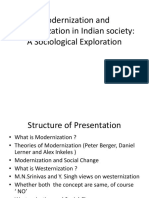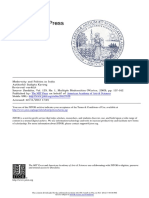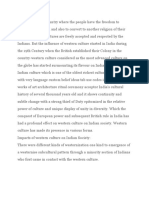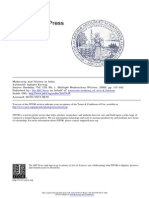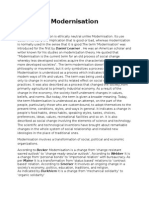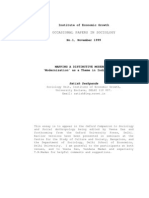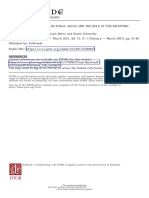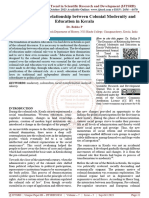.
"*******
PROCESSES OF MODERNIZATION
Modernization in India started mafnly with the Westen
allythrough establishment of the British ruleThis.contact
contac eapeci
tstoricity which brought about many far reaching changes inhada.specaD
culture and
socia structure of the Indian society. Not all of them, however, could be
called modernizing.l9 The basic direction of this contact was towards
modernization, but in the process a variety of traditional institutions ako
got reinforcement. This demonstrates the weakness of assuming a neat
contrariety between tradition and modernity. his polarity may be mor
heuristic than reab However, only after the establishment of British rule
in India, modern cultural institutions and forms of social structure were
introduced. In this respect the impact of Western tradition fundamentally
differed from that of Islam, although both were heterogenetic and both began
with political domination and rulership. The Western tradition at the time
of contact had itself undergone
fundamental transformations through
Industrial Revolution and social reformation. ts traditional principle of
hierarchy in stratification represented both by Church and feudalism were
shaken; its medieval holism of value system was seriously jeopardized by
emergence of Protestantism, and was on the way out tplace-was-Bow
r sbeing-takes by rational-individualism in economy and society. The basic
w dynamism to all these proccsses was imparted by cumulative chain
Cha of innovations in science and technology. It was a period of extreme
optimism and ever more accelerated rate of social change in the West,
particularly Britain.
This social background to a large extent determined the attitude of the
British rulers and administrators about modernzation in India; another
determining factor was their colonial status. With the exception ofa handful
of Orientalists who were overwhelmed by the textual grandeur of Indian
tradition, the majority of British missionaries and acdministrators were only
impressed by contrasts which Indian society presented to their own Western
society.20 Indian society appeared to them as consisting of discrete plural
traditions of castes, sub-castes and tribes devoid of a systematic binding
force of a universal nature.21 The significance of British contribution to
modernization mainly lies in the creation ofsuch networks of social structure
and culture which were modern and pan-Indian.
Initially, the contact led to growth of a modernizing sub-culture or Little
tradition of Westernization, especially during the seventeenth century in
Bengal, Madras and Bombay, where a small nucleus ol interpreters, trader
curn-middlemen emerged who were slowly being socialized to Western ways;
�MODERN1zATION OF INDIAN TRADITION:
ANALYSIS 203
which emphasized assimiiation of
sects
subsequendy, there also emerged
Western modes of learning (e.g. Brahmo Samaj,
Wes tern cultural norms, and r a n a crusade against
obscurantism in
Prarthana Samaj, ctc.); these also
on one hand and the
consolidation
Hindu traditions. These movements the
middle of the nineteenth century on
of the British power towards the
of a modernizing Great tradition. Its
other, finally Bed to the institution
were: a legal system,
universalistic expansion of Wcstern form
components
of education, urbanization and industrialization, spread of new means of
reforms. Along with these modern-
communication and transport and social
also took place. For instance,
ization norms structural modernization
and judiciary, army, and
rational bureaucratic systems of administration
clite and entrepreneurs came
industrial bureaucracy, new classes of business
of political elite and
into being. These were accompanied by emergence
a nationalist leadeship by the
middle of the nineteenth century. Growth
contributed to the emergence of industrial
of industrial entrepreneurship also
on corporate lines as in
the West.
working class and trade unions organized character throughout the
These modernizing structures had a uniform
to articulation of nationalist
country. Their development led, therefore,
aspirations in the country which itself
was a major step in the growth of
modernization.
however, one important feature of Indian
There was,
during
modernization
the British period. The growth of this process was selective and segmental.
of Indian society, such as
It integrated with the micro-structures
was not
these levels, the British by and
family, caste and village community. At
after the rebellion
large followed a policy of least interference, especially
of 1857. Moreover, some British administrators were wrongly impressed
micro-structures compared with the
by the staticness and autonomy of these
rest of the Indian society. This was especially so about the notion of village
For a long time caste and
community,22 and importance attributed to caste.
of oficers to army and
ethnic factors were given recognition in recruitment
twentieth ccntury, as
middle and lower ranks of bureaucracy. Later, in the
a communal clectorate
the nationalist movement gathered momentum,
factors have deeply influenced the
system was introduced. These historical
followed during the post-colonial period.
process of modernization which
and symbolisms to
It increased the contingency of traditional institutions
the Indian process of modernization.
and thc
This development is fully articulated in the. freedom movement
therealter. Freedom movement
pace of modernization of Indian society
new political culture of modernization. At its centre was the
ushered ina
personality of Mahatma Gandhi whosc one foot was always deoply embeddod
in
in tradition. His emergence during the peak of Westernization process
India signifies an orthogenetic responsc of Indian tradition to the new chal
or
lenges of ocial change. Gandhi sucoessfully mobiljzed Indian poopie
the attainmentof frecdom, but he could not, however, avert one serious
breakdown in the process... the partition of India into two independent
� 204 MODERNIZATION OF INDIAN TRADITION
nations. As we mentioned above, it foHowed from the
sub-cutural traditions of modernization in Hinduism growth of
uneven
conditioned by unique historicity of their own. The and Islam, caçch
quest
nationhood by the Muslim community in India refiected a for a
separate
tion along with that of crisis of aspira-
confidence.
FolHowing Independence, modcrnization process in India has undergone
a basicchange from its colonial pattern. As an integral part of develop-
mental strategy now
modernization has been envisaged for all levels of
cultural and structural
systems. Discontinuity in modernization between
macro-structures and micro-structures and between the Little
and Great
traditions, as during the British regime, has now been
Entroduction of adult suffrage and a federal consciously abolished.
cal structure have carried parliamentary form of politi-
politicization every sector of social
to
Conscious legaB reforms in Hindu marriage and inheritance lawsorganization.
have deeply
affected the foundations of traditional Hindu family structure.
Community
Development Projects have carried the cultural norms and role-structures
of modernity to each and every village in India, and this, coupled with
introduction of land reforms and clective villagc
a
panchayats,
villagers to bureaucratic form of participation in local level has
initiated
and administration management
of justice. Caste has in the process undergone radical
transformation of roles, developed new functional adaptations and activated
aspirations unleashed by democratization of polity and power structure.
We have analysedin detail how caste is increasingly
tional character. Now it functions as an developing an associa
the process of modernization.
important structural network in
As the process of modernization becomes all
encompassing, it also generates
inter-structural tensions and conflicts between traditions (past and contem-
porary). Future course of modernization in India would depend much
on the manner in which
thesc tensions are resolved as modernization gathers
momentum. In many developing countries in Asia modernization
uted to
contri-
structural and cultural brcakdown in society. The cases of China,
a
Indonesia, Burma and Pakistan could be cited. The only successful case
of modernization in Asia is that of
Japan, but there too its institutionali.
zation has not been without a breakdown
following the Second World War

